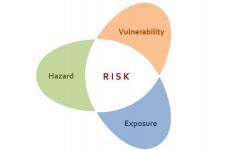Disaster Risk Reduction For The Built Environment
There has been limited research into operational disaster risk management for the built environment particularly in disaster preparedness response and building back better in recovery. Ten Notes on good practice 120509doc 5.
 The Disaster Risk Reduction Drr Diagram Executive Functioning Skills Social Development Disasters
The Disaster Risk Reduction Drr Diagram Executive Functioning Skills Social Development Disasters
1 day ago Translating the Sendai Framework for Disaster Risk Reduction into practical mechanisms be they through risk-informed investment or insurance products that support disaster risk reduction is of.

Disaster risk reduction for the built environment. It has been identified that the construction industry and built environment professionals have a significant role to play in disaster risk reduction in both pre and post disaster situations. There is a clear relationship between disaster risk reduction and the built environment disciplines. The ability resources andor willingness to mitigate prepare respond or recover also contributes to vulnerability.
The hazards can be natural or human derived and include earthquakes floods cyclones droughts price spikes conflict and contagious diseases. It shows how their skills and expertise can be applied at all stages of disaster management. 2 days ago A WWF program providing guidance resources and tools for practitioners and policymakers to integrate the environment throughout the full disaster management cycle including disaster risk reduction recovery and reconstruction to support communities in building safer greener and more resilient.
The chapter also discusses most of the disaster risk reduction activities that are primarily related to detection and emergency responsepreparedness. The contents highlight the positive roles that practitioners. Disasters tend to hit the poorest hardest as they are often made vulnerable by their social and economic circumstance lack of access to education and other basic services and resources.
Built-in disaster risk reduction DRR to advocate for the deployment of the appropriate built environment professionals in support of DRR activities to develop tools frameworks models to support built environment organisations in complex environments in a variety of global contexts. 2 21Disaster Risk Reduction 21 Learning Objectives 21 22 Key DRR Concepts and Terms 21 23 International Approaches to DRR 26 231 Milestones in History of DRR 26 232 Sendai Framework for Disaster Risk Reduction 29 233 Making Cities Resilient Campaign 31 24 Community Resilience 32 25 Risk Management 34. Effects associated with volcanoes can be divided into primary and secondary.
Apr 07 2017 Disaster Risk Reduction for the Built Environment provides a multi-facetted introduction to how a wide range of risk reduction options can be mainstreamed into formal and informal construction decision making processes so that Disaster Risk Reduction DRR can become part of the developmental DNA. The contents highlight the positive roles that. The built environment professions in disaster risk reduction and response.
DISASTER RISK Disaster risk is determined by the overlap between hazard risk and the vulnerable system. Disaster Risk Reduction for the Built Environment provides a multi-facetted introduction to how a wide range of risk reduction options can be mainstreamed into formal and informal construction decision making processes so that Disaster Risk Reduction DRR can become part of the developmental DNA. DRR disaster risk reduction is the process of protecting the livelihoods and assets of communities and individuals from the impact of hazards.
The secondary effects are those triggered by the primary impacts. This guide is intended to demonstrate the value of using built environment professionals more widely in disaster risk reduction and response. By reducing the hazard risk or reducing the vulnerability disaster risk can be reduced.
International Conference on Disaster Resilience and Risk Reduction for Built Environment scheduled on September 27-28 2022 at San Francisco United States is for the researchers scientists scholars engineers academic scientific and university practitioners to present research activities that might want to attend events meetings seminars congresses workshops summit and. Disaster prevention and sustainable development Pre-disasterrisk Reductionphase Post-disasterrecovery Riskand vulnerability assessment Risk reduction Reconstruction Earlyrecovery transition Relief Disaster preparedness Developmentand ongoingrisk reduction T i m e Impact. Disaster Risk Reduction for the Built Environmentprovides a multi-facetted introduction to how a wide range of risk reduction options can be mainstreamed into formal and informal construction decision making processes so that Disaster Risk Reduction DRR can become part of the developmental DNA.
Disaster risk reduction DRR is a systematic approach to identifying assessing and reducing the risks of disasterIt aims to reduce socio-economic vulnerabilities to disaster as well as dealing with the environmental and other hazards that trigger them. The primary effects are those caused by the actual volcanic eruption. Disaster Risk Reduction for the Built Environment provides a multi-facetted introduction to how a wide range of risk reduction options can be mainstreamed into formal and informal construction decision making processes so that Disaster Risk Reduction DRR can become part of the developmental DNA.
The Built Environment Professions in Disaster Risk Reduction and Response. Here it has been strongly influenced by the mass of research on vulnerability that has appeared in print since the mid-1970s as well as the. DRR limits the negative impacts of these events by working to reduce their size.
 Disaster Risk Management Un Spider Knowledge Portal
Disaster Risk Management Un Spider Knowledge Portal
 In Ijar Vol 12 No 1 Download Articles On The Role Of Universities As Agent Of Change In The City The U Built Environment Architecture Plan Agent Of Change
In Ijar Vol 12 No 1 Download Articles On The Role Of Universities As Agent Of Change In The City The U Built Environment Architecture Plan Agent Of Change